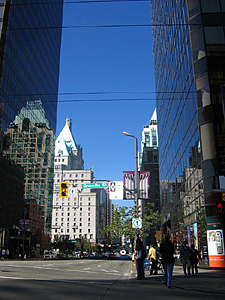Published October 10th 2006
Urban landscapes
Keywords:
Even though you can't get to fabulous landscapes, mountains and widestretched plains, you might be able to shoot some 'scapes any way. Cityscapes...

Great urban landscape: mountain lake (a puddle), bush in the foreground (a shooping cart) and a ridge of mountains (an office building) against the sky.
[Nikon D200, Nikkor 18-200 f3.5-5.6 VR]
[Nikon D200, Nikkor 18-200 f3.5-5.6 VR]
I'd love to shoot in the Rockies. Sunrise in the Maroon Bells is a dream. Death Valley would be nice as well as a view to Matterhorn or the plains of Camargue. But reality is that I'm in flat little Denmark 98% of the time and in the city of Copenhagen about 98% of that time, and such landscapes just aren't readily available in the outskirts of this town.
We do have some really nice landscapes here in Denmark, and I particularly enjoy shooting along the Danish coast, but when I just pop out for a couple of hours of shooting, I can't make it to anywhere really pristine.
In stead I shoot urban landscapes.
More urbex
I just recently learned that what I do a lot is called urbex - urban exploration.Well, there's so much to learn.
Here's som urbex shots:
- Old B&W shipyard
- Harbour walk
- Old boats
- Harbour night
- Night HDR
The same... just different
I have always been fascinated by great landscape photography. I have read books, seen exhibitions and surfed websites with landscapes and shot quite a few myself. Real landscapes. Out in nature, where the air is fresh and the sky is high.But even though I may prefer such sceneries, it's not every time I want to shoot with a tripod, slow shutter speeds and f16 that I can go out in the countryside or to the ocean -- not to mention the mountains. But I can cruise around town and look for urban landscapes. And shooting landscapes in the city, cityscapes, can be great fun and produce some great images.
My basic technique is the same as when shooting in nature:
I try to capture the great vistas.
I shoot wideangle predominantly.
I use a tripod and fairly small apertures (equals slow shutter speeds).
I compose pictures to get both foreground and sky.
I aim to get an impression of the perspective that I see with my eyes.
Water
I love water in landscape pictures, and because of this I'm attracted to the harbour area of my hometown. Luckily Copenhagen has a lot of water, and luckily the harbour area isn't that developed yet. It's still working as a port, even though not as busy as the old days. But still it hasn't been covered with buildings, so there's a lot of space. There is usually lots of room in harbours. Their rugged and unordered appearance make them good subjects for interesting shoots. Many ports are still accessible -- if not by car, then at least for pedestrians.I also like shooting in rainy weather or just after. This being October means that there's a lot of shooting opportunities in that respect. Cloud cover is also varying and breaking clouds are always great on landscapes... cityscapes. The clouds make for some moody pictures. Sun ios great and a blue sky with scattered white cloudes is always a fantastic backdrop. But a murky sky, on the other hand, can create a slightly depressive mood, which I find fits the worn down city perfectly.

A real landscape -- just to set things straight. From the Rockies, CO
[Minolta Dynax 7, Sigma 24-70mm f2.8, Provia 100]
[Minolta Dynax 7, Sigma 24-70mm f2.8, Provia 100]
Landscape technique
For landscapes -- also the urban ones -- I use the same techniques as many others.I tend to use a wideangle. My preference is a 24mm equivalent whether it's a film body or a digital one. On my D200 that calls for the 18-200 VR. My Minolta 7D does fine with the Vivitar 19-35mm f3.5-4.5 while the Minolta film body will do a fantastic job with the Sigma 24-70mm f2.8 zoom.
I use a tripod. That gives me several advantages. Stability first of all. I want that because I want to stop down to about f8-f11 to get sharpness and depth-of-field, which again gives me slower shutter speeds with camera shake as a potential risk.
The tripod also slows down my pace and forces me to think. I compose with greater care and often aim for a low stance. My Manfrotto tripod allows for me to get all down to ground level if I remove the center post -- which I do most of the time.
I like to use one of three basic compositions:
- horizon low, lots of sky
- horizon high, lots of foreground
- horizon smack-dab-in-the-center
The first one is great when the sky is nice with lots of variation. The second on is good for perspective if you have something interesting to put in the foreground. The last one I particularly like when I have a very flat and distant horizon line and fairly little variation in sky and foreground. I yields some really "empty" pictures with an impression of lots and lots of distance and space.
A bit more
I have a few more urban landscapes on the site:A cloudy day on the harbour
A rainy day out
Keywords:



